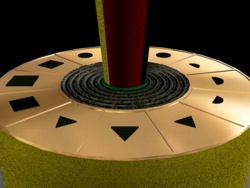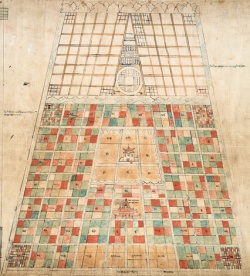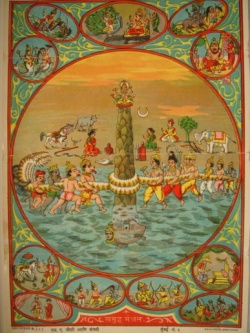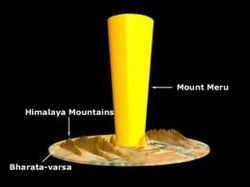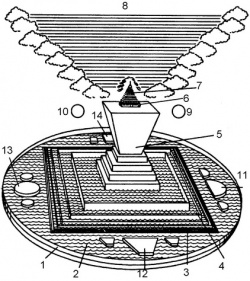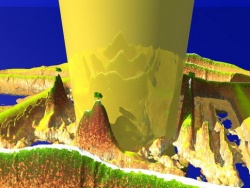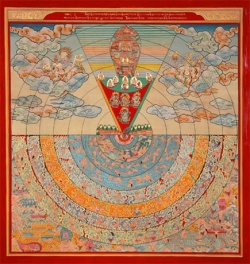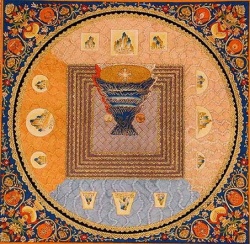A Description of Jambudvipa
King Pariksit said to Sukadeva Gosvami: O brahmana, you have already informed me that the radius of Bhu-mandala extends as far as the sun spreads its light and heat and as far as the moon and all the stars can be seen.
In this verse it is stated that the planetary system known as Bhu-mandala extends to the limits of the sunshine. According to modern science, the sunshine reaches earth from a distance of 93,000,000 miles. If we calculate according to this modern information, 93,000,000 miles can be considered the radius of Bhu-mandala. In the Gayatri mantra, we chant om bhur bhuvah svah. The word bhur refers to Bhu-mandala. Tat savitur varenyam: the sunshine spreads throughout Bhu-mandala. Therefore the sun is worshipable. The stars, which are known as naksatra, are not different suns, as modern astronomers suppose. From Bhagavad-gita (10.21) we understand that the stars are similar to the moon (naksatranam aham sasi). Like the moon, the stars reflect the sunshine. Apart from our modern distinguished estimations of where the planetary systems are located, we can understand that the sky and its various planets were studied long, long before Srimad-Bhagavatam was compiled. Sukadeva Gosvami explained the location of the planets, and this indicates that the information was known long, long before Sukadeva Gosvami related it to Maharaja Pariksit. The location of the various planetary systems was not unknown to the sages who flourished in the Vedic age.
My dear Lord, the rolling wheels of Maharaja Priyavrata's chariot created seven ditches, in which the seven oceans came into existence. Because of these seven oceans, Bhu-mandala is divided into seven islands. You have given a very general description of their measurement, names and characteristics. Now I wish to know of them in detail. Kindly fulfill my desire.
When the mind is fixed upon the Supreme Personality of Godhead in His external feature made of the material modes of nature--the gross universal form--it is brought to the platform of pure goodness. In that transcendental position, one can understand the Supreme Personality of Godhead, Vasudeva, who in His subtler form is self-effulgent and beyond the modes of nature. O my lord, please describe vividly how that form, which covers the entire universe, is perceived.
Maharaja Pariksit had already been advised by his spiritual master, Sukadeva Gosvami, to think of the universal form of the Lord, and therefore, following the advice of his spiritual master, he continuously thought of that form. The universal form is certainly material, but because everything is an expansion of the energy of the Supreme Personality of Godhead, ultimately nothing is material. Therefore Pariksit Maharaja's mind was saturated with spiritual consciousness. Srila Rupa Gosvami has stated:
prapancikataya buddhya
hari-sambandhi-vastunah
mumuksubhih parityago
vairagyam phalgu kathyate
Everything, even that which is material, is connected with the Supreme personality of Godhead. Therefore everything should be engaged in the service of the Lord. Srila Bhaktisiddhanta Sarasvati Thakura translates this verse as follows:
hari-sevaya yaha haya anukula
visaya baliya tahara tyage haya bhula
"One should not give up anything connected with the Supreme personality of Godhead, thinking it material or enjoyable for the material senses." Even the senses, when purified, are spiritual. When Maharaja Pariksit was thinking of the universal form of the Lord, his mind was certainly situated on the transcendental platform. Therefore although he might not have had any reason to be concerned with detailed information of the universe, he was thinking of it in relationship with the Supreme Lord, and therefore such geographical knowledge was not material but transcendental. Elsewhere in Srimad-Bhagavatam (1.5.20) Narada Muni has said, idam hi visvam bhagavan ivetarah: the entire universe is also the Supreme personality of Godhead, although it appears different from Him. Therefore although Pariksit Maharaja had no need for geographical knowledge of this universe, that knowledge was also spiritual and transcendental because he was thinking of the entire universe as an expansion of the energy of the Lord.
In our preaching work also, we deal with so much property and money and so many books bought and sold, but because these dealings all pertain to the Krsna consciousness movement, they should never be considered material. That one is absorbed in thoughts of such management does not mean that he is outside of Krsna consciousness. If one rigidly observes the regulative principle of chanting sixteen rounds of the maha-mantra every day, his dealings with the material world for the sake of spreading the Krsna consciousness movement are not different from the spiritual cultivation of Krsna consciousness.
The great rsi Sukadeva Gosvami said: My dear King, there is no limit to the expansion of the Supreme Personality of Godhead's material energy. This material world is a transformation of the material qualities [[[sattva-guna]], rajo-guna and tamo-guna], yet no one could possibly explain it perfectly, even in a lifetime as long as that of Brahma No one in the material world is perfect, and an imperfect person could not describe this material universe accurately, even after continued speculation. O King, I shall nevertheless try to explain to you the principal regions, such as Bhu-goloka [[[Bhuloka]]], with their names, forms, measurements and various symptoms.
The material world is only one fourth of the Supreme personality of Godhead's creation, but it is unlimited and impossible for anyone to know or describe, even with the qualification of a life as long as that of Brahma, who lives for millions and millions of years. Modern scientists and astronomers try to explain the cosmic situation and the vastness of space, and some of them believe that all the glittering stars are different suns. From Bhagavad-gita, however, we understand that all these stars (naksatras) are like the moon, in that they reflect the sunshine. They are not independent luminaries. Bhuloka is explained to be that portion of outer space through which the heat and light of the sun extend. Therefore it is natural to conclude that this universe extends in space as far as we can see and encompasses the glittering stars. Srila Sukadeva Gosvami admitted that to give full details of this expansive material universe would be impossible, but nevertheless he wanted to give the King as much knowledge as he had received through the parampara system. We should conclude that if one cannot comprehend the material expansions of the Supreme personality of Godhead, one certainly cannot estimate the expansiveness of the spiritual world. The Brahma-samhita (5.33) confirms this:
advaitam acyutam anadim ananta-rupam
adyam purana-purusam nava-yauvanam ca
The limits of the expansions of Govinda, the Supreme personality of Godhead, cannot be estimated by anyone, even a person as perfect as Brahma, not to speak of tiny scientists whose senses and instruments are all imperfect and who cannot give us information of even this one universe. We should therefore be satisfied with the information obtainable from Vedic sources as spoken by authorities like Sukadeva Gosvami.
The planetary system known as Bhu-mandala resembles a lotus flower, and its seven islands resemble the whorl of that flower. The length and breadth of the island known as Jambudvipa, which is situated in the middle of the whorl, are one million yojanas [eight million miles]. Jambudvipa is round like the leaf of a lotus flower.
In Jambudvipa there are nine divisions of land, each with a length of 9,000 yojanas [72,000 miles]. There are eight mountains that mark the boundaries of these divisions and separate them nicely.
Srila Visvanatha Cakravarti Thakura gives the following quotation from the Vayu purana, wherein the locations of the various mountains, beginning with the Himalayas, are described.
Amidst these divisions, or varsas, is the varsa named Ilavrta, which is situated in the middle of the whorl of the lotus. Within Ilavrta-varsa is Sumeru Mountain, which is made of gold. Sumeru Mountain is like the pericarp of the lotuslike Bhu-mandala planetary system. The mountain's height is the same as the width of Jambudvipa--or, in other words, 100,000 yojanas [800,000 miles]. Of that, 16,000 yojanas [128,000 miles] are within the earth, and therefore the mountain's height above the earth is 84,000 yojanas [672,000 miles]. The mountain's width is 32,000 yojanas [256,000 miles] at its summit and 16,000 yojanas at its base.
Just north of Ilavrta-varsa--and going further northward, one after another--are three mountains named Nila, Sveta and Srngavan. These mark the borders of the three varsas named Ramyaka, Hiranmaya and Kuru and separate them from one another. The width of these mountains is 2,000 yojanas [16,000 miles]. Lengthwise, they extend east and west to the beaches of the ocean of salt water. Going from south to north, the length of each mountain is one tenth that of the previous mountain, but the height of them all is the same.
It appears from these verses that aside from the sun and moon, there is an invisible planet called Rahu. The movements of Rahu cause both solar and lunar eclipses. We suggest that the modern expeditions attempting to reach the moon are mistakenly going to Rahu.
Similarly, south of Ilavrta-varsa and extending from east to west are three great mountains named (from north to south) Nisadha, Hemakuta and Himalaya. Each of them is 10,000 yojanas [80,000 miles] high. They mark the boundaries of the three varsas named Hari-varsa, Kimpurusa-varsa and Bharata-varsa [[[India]]].
In the same way, west and east of Ilavrta-varsa are two great mountains named Malyavan and Gandhamadana respectively. These two mountains, which are 2,000 yojanas [16,000 miles] high, extend as far as Nila Mountain in the north and Nisadha in the south. They indicate the borders of Ilavrta-varsa and also the varsas known as Ketumala and Bhadrasva.
There are so many mountains, even on this planet earth. We do not think that the measurements of all of them have actually been calculated. While passing over the mountainous region from Mexico to Caracas, we actually saw so many mountains that we doubt whether their height, length and breadth have been properly measured. Therefore, as indicated in Srimad-Bhagavatam by Sukadeva Gosvami, we should not try to comprehend the greater mountainous areas of the universe merely by our calculations. Sukadeva Gosvami has already stated that such calculations would be very difficult even if one had a duration of life like that of Brahma. We should simply be satisfied with the statements of authorities like Sukadeva Gosvami and appreciate how the entire cosmic manifestation has been made possible by the external energy of the Supreme Personality of Godhead. The measurements given herein, such as 10,000 yojanas or 100,000 yojanas, should be considered correct because they have been given by Sukadeva Gosvami. Our experimental knowledge can neither verify nor disprove the statements of Srimad-Bhagavatam. We should simply hear these statements from the authorities. If we can appreciate the extensive energy of the Supreme Personality of Godhead, that will benefit us.
On the four sides of the great mountain known as Sumeru are four mountains--Mandara, Merumandara, Suparsva and Kumuda--which are like its belts. The length and height of these mountains are calculated to be 10,000 yojanas [80,000 miles].
Standing like flagstaffs on the summits of these four mountains are a mango tree, a rose apple tree, a kadamba tree and a banyan tree. Those trees are calculated to have a width of 100 yojanas [800 miles] and a height of 1,100 yojanas [8,800 miles]. Their branches also spread to a radius of 1,100 yojanas.
O Maharaja Pariksit, best of the Bharata dynasty, between these four mountains are four huge lakes. The water of the first tastes just like milk; the water of the second, like honey; and that of the third, like sugarcane juice. The fourth lake is filled with pure water. The celestial beings such as the Siddhas, Caranas and Gandharvas, who are also known as demigods, enjoy the facilities of those four lakes. Consequently they have the natural perfections of mystic yoga, such as the power to become smaller than the smallest or greater than the greatest. There are also four celestial gardens named Nandana, Caitraratha, Vaibhrajaka and Sarvatobhadra.
The best of the demigods, along with their wives, who are like ornaments of heavenly beauty, meet together and enjoy within those gardens, while their glories are sung by lesser demigods known as Gandharvas.
On the lower slopes of Mandara Mountain is a mango tree named Devacuta. It is 1,100 yojanas high. Mangoes as big as mountain peaks and as sweet as nectar fall from the top of this tree for the enjoyment of the denizens of heaven.
In the Vayu purana there is also a reference to this tree by great learned sages:
When all those solid fruits fall from such a height, they break, and the sweet, fragrant juice within them flows out and becomes increasingly more fragrant as it mixes with other scents. That juice cascades from the mountain in waterfalls and becomes a river called Arunoda, which flows pleasantly through the eastern side of Ilavrta.
The pious wives of the Yaksas act as personal maidservants to assist Bhavani, the wife of Lord Siva. Because they drink the water of the River Arunoda, their bodies become fragrant, and as the air carries away that fragrance, it perfumes the entire atmosphere for eighty miles around.
Similarly, the fruits of the jambu tree, which are full of pulp and have very small seeds, fall from a great height and break to pieces. Those fruits are the size of elephants, and the juice gliding from them becomes a river named Jambu-nadi. This river falls a distance of 10,000 yojanas, from the summit of Merumandara to the southern side of Ilavrta, and floods the entire land of Ilavrta with juice.
We can only imagine how much juice there might be in a fruit that is the size of an elephant but has a very tiny seed. Naturally the juice from the broken jambu fruits forms waterfalls and floods the entire land of Ilavrta. That juice produces an immense quantity of gold, as will be explained in the next verses.
The mud on both banks of the River Jambu-nadi, being moistened by the flowing juice and then dried by the air and the sunshine, produces huge quantities of gold called Jambu-nada. The denizens of heaven use this gold for various kinds of ornaments. Therefore all the inhabitants of the heavenly planets and their youthful wives are fully decorated with golden helmets, bangles and belts, and thus they enjoy life.
By the arrangement of the Supreme Personality of Godhead, the rivers on some planets produce gold on their banks. The poor inhabitants of this earth, because of their incomplete knowledge, are captivated by a so-called bhagavan who can produce a small quantity of gold. However, it is understood that in a higher planetary system in this material world, the mud on the banks of the Jambu-nadi mixes with jambu juice, reacts with the sunshine in the air, and automatically produces huge quantities of gold. Thus the men and women are decorated there by various golden ornaments, and they look very nice. Unfortunately, on earth there is such a scarcity of gold that the governments of the world try to keep it in reserve and issue paper currency. Because that currency is not backed up by gold, the paper they distribute as money is worthless, but nevertheless the people on earth are very proud of material advancement. In modern times, girls and ladies have ornaments made of plastic instead of gold, and plastic utensils are used instead of golden ones, yet people are very proud of their material wealth. Therefore the people of this age are described as mandah sumanda-matayo manda-bhagya hy upadrutah (Bhag. 1.1.10). In other words, they are extremely bad and slow to understand the opulence of the Supreme Personality of Godhead. They have been described as sumanda-matayah because their conceptions are so crippled that they accept a bluffer who produces a little gold to be God. Because they have no gold in their possession, they are actually poverty-stricken, and therefore they are considered unfortunate.
Sometimes these unfortunate people want to be promoted to the heavenly planets to achieve fortunate positions, as described in this verse, but pure devotees of the Lord are not at all interested in such opulence. Indeed, devotees sometimes compare the color of gold to that of bright golden stool. Sri Caitanya Mahaprabhu has instructed devotees not to be allured by golden ornaments and beautifully decorated women. Na dhanam na janam na sundarim: a devotee should not be allured by gold. beautiful women or the prestige of having many followers. Sri Caitanya Mahaprabhu, therefore, confidentially prayed, mama janmani janmanisvare bhavatad bhaktir ahaituki tvayi: "My Lord, please bless Me with Your devotional service. I do not want anything else." A devotee may pray to be delivered from this material world. That is his only aspiration.
The humble devotee simply prays to the Lord, "Kindly pick me up from the material world, which is full of varieties of material opulence, and keep me under the shelter of Your lotus feet."
Srila Narottama dasa Thakura prays:
"O my Lord, O son of Nanda Maharaja, now You are standing before me with Your consort, the daughter of Vrsabhanu, Srimati Radharani. Kindly accept me as the dust of Your lotus feet. please do not kick me away, for I have no other shelter."
Similarly, Prabodhananda Sarasvati indicates that the position of the demigods, who are decorated with golden helmets and other ornaments, is no better than a phantasmagoria (tri-dasa-pur akasa-puspayate). A devotee is never allured by such opulences. He simply aspires to become the dust of the lotus feet of the Lord.
On the side of Suparsva Mountain stands a big tree called Mahakadamba, which is very celebrated. From the hollows of this tree flow five rivers of honey, each about five vyamas wide. This flowing honey falls incessantly from the top of Suparsva Mountain and flows all around Ilavrta-varsa, beginning from the western side. Thus the whole land is saturated with the pleasing fragrance.
The distance between one hand and another when one spreads both his arms is called a vyama. This comes to about eight feet. Thus each of the rivers was about forty feet wide, making a total of about two hundred feet.
The air carrying the scent from the mouths of those who drink that honey perfumes the land for a hundred yojanas around.
Similarly, on Kumuda Mountain there is a great banyan tree, which is called Satavalsa because it has a hundred main branches. From those branches come many roots, from which many rivers are flowing. These rivers flow down from the top of the mountain to the northern side of Ilavrta-varsa for the benefit of those who live there. Because of these flowing rivers, all the people have ample supplies of milk, yogurt, honey, clarified butter [ghee], molasses, food grains, clothes, bedding, sitting places and ornaments. All the objects they desire are sufficiently supplied for their prosperity, and therefore they are very happy.
The prosperity of humanity does not depend on a demoniac civilization that has no culture and no knowledge but has only gigantic skyscrapers and huge automobiles always rushing down the highways. The products of nature are sufficient. When there is a profuse supply of milk, yogurt, honey, food grains, ghee, molasses, dhotis, saris, bedding, sitting places and ornaments, the residents are actually opulent. When a profuse supply of water from the river inundates the land, all these things can be produced, and there will not be scarcity. This all depends, however, on the performance of sacrifice as described in the Vedic literature.
annad bhavanti bhutani
parjanyad anna-sambhavah
yajnad bhavati parjanyo
yajnah karma-samudbhavah
"All living bodies subsist on food grains, which are produced from rains. Rains are produced by performance of yajna [[[Wikipedia:sacrifice|sacrifice]]], and yajna is born of prescribed duties." These are the prescriptions given in Bhagavad-gita (3.14). If people follow these principles in full Krsna consciousness, human society will be prosperous, and they will be happy both in this life and in the next.
The residents of the material world who enjoy the products of these flowing rivers have no wrinkles on their bodies and no grey hair. They never feel fatigue, and perspiration does not give their bodies a bad odor. They are not afflicted by old age, disease or untimely death, they do not suffer from chilly cold or scorching heat, nor do their bodies lose their luster. They all live very happily, without anxieties, until death.
This verse hints at the perfection of human society even within this material world. The miserable conditions of this material world can be corrected by a sufficient supply of milk, yogurt, honey, ghee, molasses, food grains, ornaments, bedding, sitting places and so on. This is human civilization. Ample food grains can be produced through agricultural enterprises, and profuse supplies of milk, yogurt and ghee can be arranged through cow protection. Abundant honey can be obtained if the forests are protected. Unfortunately, in modern civilization, men are busy killing the cows that are the source of yogurt, milk and ghee, they are cutting down all the trees that supply honey, and they are opening factories to manufacture nuts, bolts, automobiles and wine instead of engaging in agriculture. How can the people be happy? They must suffer from all the misery of materialism. Their bodies become wrinkled and gradually deteriorate until they become almost like dwarves, and a bad odor emanates from their bodies because of unclean perspiration resulting from eating all kinds of nasty things. This is not human civilization. If people actually want happiness in this life and want to prepare for the best in the next life, they must adopt a Vedic civilization. In a Vedic civilization, there is a full supply of all the necessities mentioned above.
There are other mountains beautifully arranged around the foot of Mount Meru like the filaments around the whorl of a lotus flower. Their names are Kuranga, Kurara, Kusumbha, Vaikanka, Trikuta, Sisira, Patanga, Rucaka, Nisadha, Sinivasa, Kapila, Sankha, Vaidurya, Jarudhi, Hamsa, Rsabha, Naga, Kalanjara and Narada.
On the eastern side of Sumeru Mountain are two mountains named Jathara and Devakuta, which extend to the north and south for 18,000 yojanas [144,000 miles]. Similarly, on the western side of Sumeru are two mountains named Pavana and Pariyatra, which also extend north and south for the same distance. On the southern side of Sumeru are two mountains named Kailasa and Karavira, which extend east and west for 18,000 yojanas, and on the northern side of Sumeru, extending for the same distance east and west, are two mountains named Trisrnga and Makara. The width and height of all these mountains is 2,000 yojanas [16,000 miles]. Sumeru, a mountain of solid gold shining as brilliantly as fire, is surrounded by these eight mountains.
In the middle of the summit of Meru is the township of Lord Brahma. Each of its four sides is calculated to extend for ten million yojanas [eighty million miles]. It is made entirely of gold, and therefore learned scholars and sages call it Satakaumbhi.
Srila Visvanatha Cakravarti Thakura confirms that the townships of Lord Brahma and the eight subordinate governors of the planetary systems, beginning with Indra, are mentioned in other Puranas. merau nava-purani syur manovaty amaravati tejovati samyamani tatha krsnangana para sraddhavati gandhavati tatha canya mahodaya yasovati ca brahmendra bahyadinam yatha-kramam Brahma's township is known as Manovati, and those of his assistants such as Indra and Agni are known as Amaravati, Tejovati, Samyamani, Krsnangana, Sraddhavati, Gandhavati, Mahodaya and Yasovati. Brahmapuri is situated in the middle, and the other eight puris surround it in all directions.
Thus end the Bhaktivedanta purports of the Fifth Canto, Sixteenth Chapter of the Srimad-Bhagavatam, entitled, "A Description of Jambudvipa." Pages A Description of Jambudvipa : Srimad-Bhagavatam Canto 5 A Description of the Island of Jambudvipa : Srimad-Bhagavatam Canto 5 Grandfather Bhisma on Cow Protection Mahabharata Summary Maharishi Bhrigu Studying the Structure of the Universe :
The members of such a government are described as dasyu, thieves.
Their main activity will be to plunder the wealth of the people. It is stated in Srimad-Bhagavatam that in the modern age the heads of government will be plunderers and thieves. The President should not become such a rogue that he exploits the citizens for his own benefit. Because of the material body, the living entity is subjected to many tribulations. Under the circumstances, the world will periodically suffer from such upsurges and outbreaks of war, which are the consequences of not being God conscious.
